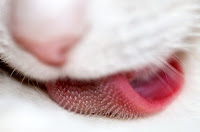 |
| Cat Tongue |
A cat's tongue is an essential piece of cat anatomy. When you see a cat scoop up water from a cup with her/his tongue it is impressive. It is an essential grooming tool as well.
The "hairs" are called papillae. As can be clearly seen in the photograph, they point backwards almost like small barbs. They contain the same material that makes our fingernails and the claws of a cat (keratin) , which provides the necessary hardness to the papillae that makes them so useful.
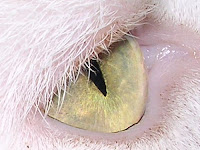 |
| Cat anatomy - Cat eye showing slit aperature photo by EnKayTee. |
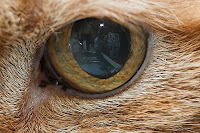 |
| Cat anatomy - Cat eyes - photo by parl. |
It is thought that cat eyes are less effective than humans, in regard to color reception. But it is known that a cat's eyes are much better for seeing in the dark. This is due to a reflective layer at the back of the eye which reflects light back onto the retina magnifying the reception. They also have that slit of an aperture for a reason.
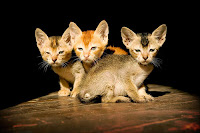
Cat anatomy - Pronounced cat ears on these kittens in Burma. Photo by phitar.
A cat's ears are very mobile. The outer ear (the part you see) called the earflap or more technically Pinna (the two flaps are called Pinnae) can swivel to pick up sound more effectively than humans.The ear is very expressive and they are a means of communication.
There are apparently 5 basic ear signals.
---alert mode....ears point to source of sound, which will be ahead as cat faces source of interest. Ears may swivel to side for short time if another sound occurs.
---agitated mode....ears twitch nervously. If the cat has ear tufts. this twitching is more noticeable.
---defensive mode....ears become flattened for protection.
---aggressive mode....ears are rotated to show the back of the ear ready to be flattened. This is a signal to beware to other animals. In the wild cat and in some wild cat hybrids you'll see markings on the back of the ear to reinforce this signal.
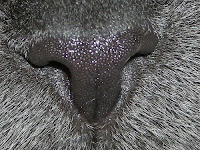 |
| Cat anatomy - cat nose photo by red_a_27 |
A cat's sense of smell is 14 times better than a human's sense of smell because the organ sensing odor particles is larger. If one watches cats it is apparent that the cat will rely on her/his heightened sense of smell very frequently. Smell is much more an integral part of a cat's life than for us. A cat's world is often centered around her sense of smell.
A cat decides what to eat by how attractive the food smells. A cat checks out whether there ahve been other animals and cats in the vicinity by her sense of smell. She will leave her odor on you by head butting and rubbing up against you to create a friendly smelling environment for herself and as a greeting. Head butting is a friendly exchange of body odors.
A male cat will smell a female cat in heat. A cat establishes territory by depositing urine and pheromones (from glands in the cats feet and facial area). These are readily picked up by other cats' acute sense of smell. The age of the smell will tell the cat smelling the odor if the territory is still occupied.Male cat spraying is a useful form of communication.
In addition to the usual sensory receptors in the nose the cat has another organ that gives a boost to her sense of smell. You can see a cat use this organ because she/he will open her mouth slightly (a little like an odd smile) and breath in to suck in air to pass over the organ, which is inside the mouth. It is called Jacobson's Organ (scientific name is vomeronasal organ).
The bit of nose we see, the nose leather is quite tough to allow it to absorb rather rough treatment sometimes. The color varies according to the genotype (genetic makeup) of the cat. Cat's skin has the same color as the fur but the color of the nose leather is probably dictated by a dedicated gene. Cats with white fur have skin susceptible to damage by ultra violet light that may cause cancer. Extra care is required when she/he goes outside in hot weather.
http://www.pets.ca/
- http://www.felinefuture.com
- Catwatching - Desmond Morris
- http://cats.about.com
No comments:
Post a Comment